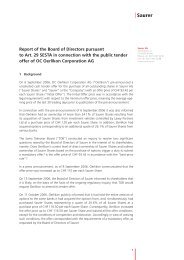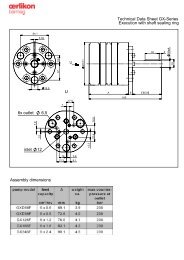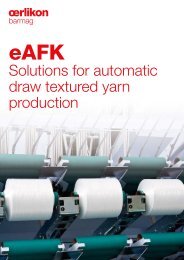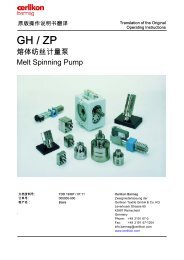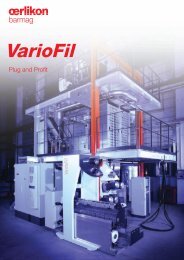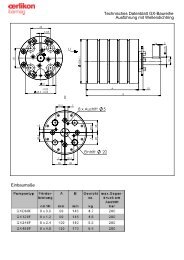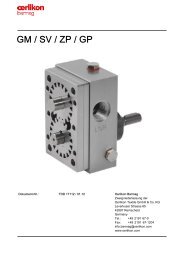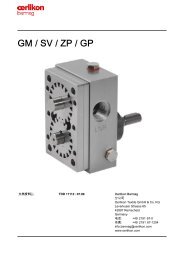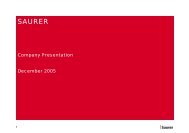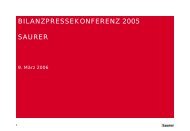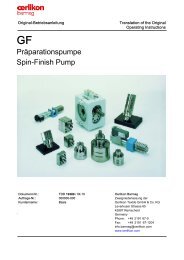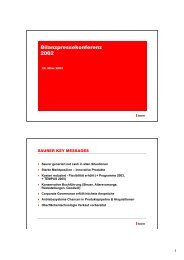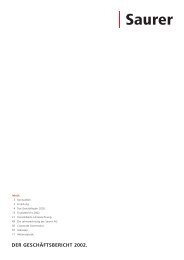THE ANNUAL REPORT 2002 - Oerlikon Barmag
THE ANNUAL REPORT 2002 - Oerlikon Barmag
THE ANNUAL REPORT 2002 - Oerlikon Barmag
You also want an ePaper? Increase the reach of your titles
YUMPU automatically turns print PDFs into web optimized ePapers that Google loves.
Accounting principles<br />
Commodity price risks The price risks related to commodities used<br />
in Saurer products are low.<br />
Composition and valuation of balance sheet items<br />
Cash includes cash in hand, balances in postal and bank accounts,<br />
as well as short-term money market funds.<br />
Marketable securities are shown at year-end market value.<br />
Changes in value are included in the income statement.<br />
Accounts receivable, trade and other receivables are included at<br />
face value, less specific provisions where appropriate.<br />
Inventories Raw materials are valued at the lower of cost and<br />
market, using the FIFO or weighted average cost method. Finished<br />
goods and work in process are valued at production cost,<br />
reduced to net realizable value should this be lower than cost.<br />
Provisions are made for items of reduced salability and excess<br />
stocks. Customer payments on account are deducted from inventories.<br />
Financial assets are included at cost less provisions for permanent<br />
impairment of value.<br />
Financial Instruments Derivative financial instruments are recorded<br />
at cost and are subsequently adjusted to fair value. With the<br />
exception of financial instruments which hedge a forecasted transaction<br />
(cash flow hedges), all adjustments in fair values are included<br />
in income.<br />
The purpose of hedge accounting is to match the impact of the<br />
hedged item and the hedging instrument in the income statement.<br />
To qualify for hedge accounting, the hedging relationship must<br />
meet several strict conditions concerning documentation, hedge<br />
effectiveness and reliability of measurement. If these conditions are<br />
not met, the transaction does not qualify as a hedge for accounting<br />
purposes. In this event fair value adjustments to the value of the<br />
derivative and the hedged item are made through the income statement.<br />
Saurer uses hedge accounting exclusively for cash flow hedges.<br />
These are used to secure future cash flows which have a high<br />
probability of occurring. The hedge instrument is recorded on the<br />
balance sheet at fair value (replacement cost) and any subsequent<br />
adjustments are booked in the hedging reserve in shareholders’<br />
equity. If the hedge relates to a transaction which will subsequently<br />
be recorded on the balance sheet, the adjustments cumulated<br />
under shareholders’ equity at that time will be included in<br />
the initial book value of the asset or liability. In all other cases the<br />
cumulative changes in fair value of the hedging instrument that<br />
have been recorded in equity are included as a charge or credit to<br />
income when the forecasted transaction is recognized.<br />
Property, plant and equipment is carried at purchase or production<br />
cost less appropriate depreciation. In the case of an impairment<br />
loss the appropriate charge is made to income.<br />
Depreciation is charged on a straight-line basis over the following<br />
periods:<br />
28<br />
Furniture, fittings and equipment<br />
Years<br />
5–12<br />
IT, office equipment 3–7<br />
Vehicles, tools 4–6<br />
Machinery 6–10<br />
Buildings: – exterior constructions 30–60<br />
– interior constructions 12–25<br />
Repair and maintenance costs are expensed directly to the income<br />
statement. Costs which give rise to an increase in value are capitalized<br />
and depreciated over the remaining useful life of the<br />
assets.<br />
Financing costs incurred in respect of the construction of property,<br />
plant and equipment are taken directly to the income statement.<br />
Leased equipment Property, plant and equipment financed<br />
through long-term financial leasing contracts, and for which the<br />
company bears the major risks (financial leasing), is capitalized and<br />
depreciated like other fixed assets. The present value of the corresponding<br />
lease obligations is included as a liability under long-term<br />
liabilities.<br />
Rental costs for short-term operational leases are charged directly to<br />
the income statement. Operating leases are not included in the balance<br />
sheet; the corresponding obligations are fully reported in the<br />
notes.<br />
Goodwill is the excess of the acquisition price of investments over<br />
the related equity value at the date of acquisition and is amortized<br />
to the income statement over a maximum period of 20 years.<br />
Amortization periods in excess of 5 years are only used in the case<br />
of strategic acquisitions where a sustainable expansion of market<br />
share can be expected. In the case of the purchase of a foreign company,<br />
goodwill is converted and fixed in Swiss Francs at the time of<br />
acquisition. The amortization of goodwill is included in administration<br />
and other expenses.<br />
The carrying value of goodwill is reviewed at least annually for all<br />
investments and, if a risk of impairment is seen, a detailed valuation<br />
is performed using Discounted Cash Flow analysis over a five-year<br />
period. If required, adjustments are then made to reduce the carrying<br />
values of goodwill for the investments affected.<br />
Where an acquisition gives rise to negative goodwill this is released<br />
to income over a period calculated to match any related costs. The<br />
release to income is recorded together with goodwill amortization<br />
in administration and other expense.<br />
Patents, licenses and trademarks are capitalized at cost and are<br />
written off on a straight-line basis over their useful life, not exceeding<br />
10 years.<br />
Provisions are set up for current legal and actual liabilities which<br />
are attributable to events in the past. The amount of the provisions<br />
is based on the expected use of funds for covering the liabilities.<br />
Retirement benefits Saurer companies operate various plans for<br />
providing employees with retirement benefits, which conform to



